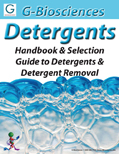Detergents & Accessories | Protein Research Products
Detergents are amphipathic molecules that possess both a hydrophobic (water-fear) and a hydrophilic (water-friend) group that allow them to act as excellent solubilization agents and additives to electrophoresis.
There are a vast number of detergents available for protein solubilization. They can be classified based on the nature of their hydrophilic head group. The three classifications are:
For more information on detergents, read the technical bulletin "Detergents: A Handbook & Selection Guide to Detergents & Detergent Removal":
 Title: Detergents: A Handbook & Selection Guide to Detergents & Detergent Removal
Title: Detergents: A Handbook & Selection Guide to Detergents & Detergent Removal
File Type: PDF
Author: G-Biosciences
In addition to the above classification, there are important properties or characteristics of detergents that can be used to aid researchers in their choice of detergent. G-Biosciences also offers detergent removal systems.
non-ionic detergents
Non-ionic detergents have a hydrophilic head group that is uncharged and are preferred for their ability to break lipid-lipid and lipid-protein interactions. They have limited ability to break protein-protein interactions and are often referred to as non-denaturing detergents and are used to isolate biologically active membrane proteins.
The non-ionic detergents are supplied as a general Research Grade, Proteomic Grade  (PG) Solutions and 2D-Detergents™. The Proteomic Grade (PG) Solutions have ultra low aldehyde (<100μM) and peroxide (<50μM) concentrations to reduce the effects of peroxidase and carbonyl compounds that negatively interact with membrane proteins. The 2D-Detergents™ have low conductivity (<10μS) and ultra low aldehyde (<100μM) and peroxide (<50μM) concentrations.
(PG) Solutions and 2D-Detergents™. The Proteomic Grade (PG) Solutions have ultra low aldehyde (<100μM) and peroxide (<50μM) concentrations to reduce the effects of peroxidase and carbonyl compounds that negatively interact with membrane proteins. The 2D-Detergents™ have low conductivity (<10μS) and ultra low aldehyde (<100μM) and peroxide (<50μM) concentrations.
Non-Ionic Detergents | Order Online
ionic detergents
 Ionic detergents have a hydrophilic head group that is charged and can be either negatively (anionic) or positively (cationic) charged. Ionic detergents are used for the complete disruption of cellular structures and denaturation of proteins for separation during gel electrophoresis. Ionic detergents bind with protein molecules, masking their native charge and rendering the protein molecules the overall charge of the ionic detergent.
Ionic detergents have a hydrophilic head group that is charged and can be either negatively (anionic) or positively (cationic) charged. Ionic detergents are used for the complete disruption of cellular structures and denaturation of proteins for separation during gel electrophoresis. Ionic detergents bind with protein molecules, masking their native charge and rendering the protein molecules the overall charge of the ionic detergent.
Ionic Detergents | Order Online
zwitterionic detergents
 Zwitterionic detergents protect the native state of proteins without altering the native charge of the protein molecules. Zwitterionic detergents are used for isoelectric focusing and 2D electrophoresis. Synthetic zwitterionic detergents are known as sulfobetaines. Sulfobetaines retain their zwitterionic characteristics over a wide range of pH. The following zwitterionic detergents are the most efficient and widely used for 2D gel electrophoresis.
Zwitterionic detergents protect the native state of proteins without altering the native charge of the protein molecules. Zwitterionic detergents are used for isoelectric focusing and 2D electrophoresis. Synthetic zwitterionic detergents are known as sulfobetaines. Sulfobetaines retain their zwitterionic characteristics over a wide range of pH. The following zwitterionic detergents are the most efficient and widely used for 2D gel electrophoresis.
Zwitterionic Detergents | Order Online
detergent removal systems
G-Biosciences offers the DetergentOUT™ line of detergent removal systems, a rapid column based protocol. DetergentOUT™ is a one step, column based system for removing free detergent from protein solutions in under 10 minutes.



